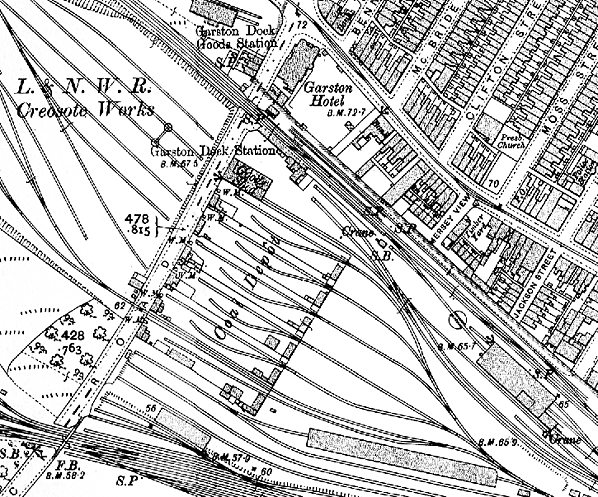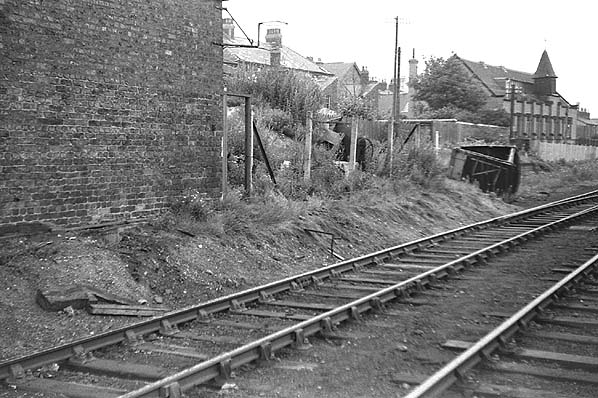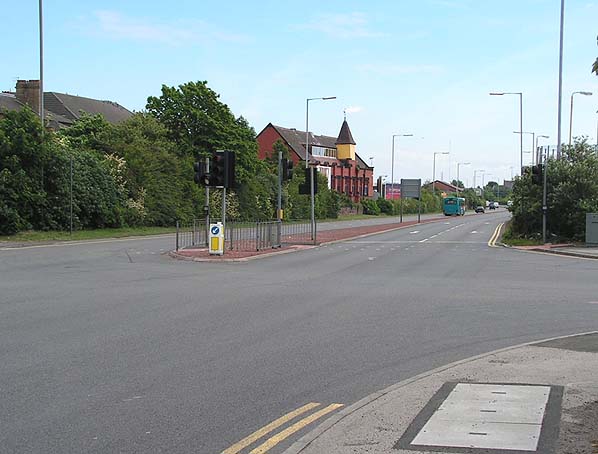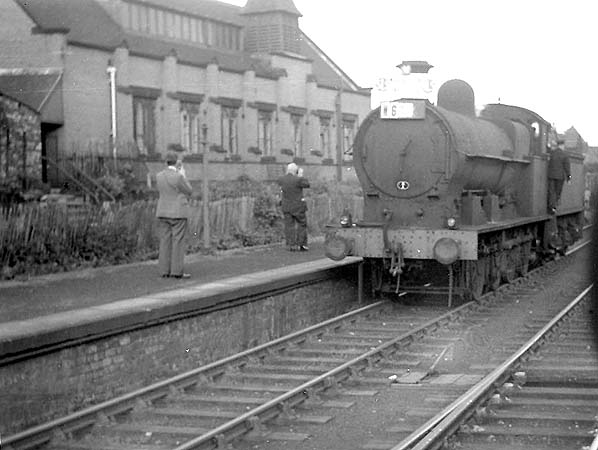Notes: Garston Dock station was the western terminus of the St Helens Canal & Railway Company (SHC&RC) Garston and Warrington railway. The Garston and Warrington line was authorised in two parts on 16 July 1846 (from Runcorn Gap to Garston) and on 22 July 1847 (Runcorn Gap to Warrington) and extended the SHC&RC’s original St Helens & Runcorn Gap Railway from Widnes westwards to Garston and eastwards to Warrington. One of the key reasons for extending the line to Garston was to give the SHC&RC access to the River Mersey at a point which deeper draft vessels could reach. The SHC&RC had a dock at Widnes that had opened in 1833 but it was constrained by tides. The Act of 1846 also made provision for the creation of an extensive dock system at Garston.
The line opened between a temporary station at Warrington and Garston on 1 July 1852. A passenger station was provided at Garston Dock which opened with the line. It was on the east side of Dock Road which crossed the line by a level crossing.
The line was double-track, and Garston Dock was provided with two platforms. The station building was on the north side of the line at the north-western end of the up (Warrington direction) platform, a modest, square brick-built structure with a hipped roof. The façade had arched openings for its two windows and door, but no such dignity was afforded to the elevation which faced the platform. Passengers walked through the station building to reach the up platform which, in 1852, would have been used for departures.
The down platform had a single-storey pent-roofed brick building and a canopy; in 1852 it would have been the arrival platform. A brick arched gateway at the north-west end of the station gave access to Dock Road. To move between the platforms passengers used the Dock Road level crossing.
The goods facilities at Garston dwarfed the passenger station. The goods station was to the south of the also on the eat side of Dock Road. Over the years it developed into an extensive facility that had a goods shed, a coal depot and numerous sidings. An engine shed, sidings and a turntable were found south-east of the station.
The dock itself was to the south-west of the station and was reached by a line that bypassed it running to the south of the goods yard. At the time of opening coal was the major commodity carried to Garston Dock, and it came from the St Helens coalfield; the coal went onward to Liverpool by boat or was exported.
Passenger trains departed alternately for St Helens or Warrington; the same was true for arrivals. On 1 May 1854 the Garston and Warrington line was extended a short distance eastwards to a station at Warrington Arpley, a joint facility shared with the Warrington & Stockport Railway (W&SR). The Warrington & Stockport line made an end-on connection with the SHC&RC at Arpley and created a through route between Garston and Manchester.
On 1 February 1858 through services were run between Garston and London Kings Cross by the Great Northern Railway (GNR). Two trains per day in each direction were provided, and onward travel to Liverpool was by river using a paddle steamer or by horse-drawn omnibus.
| From its earliest days the SHC&RC had aspirations to reach central Liverpool. Its near neighbour, the London & North Western Railway (LNWR) with which it had maintained a good working relationship for many years, had not wanted the SHC&RC to reach Liverpool, thereby creating a Liverpool and Manchester route that could rival its own. Other companies such as the GNR |
 |
and the Manchester, Sheffield & Lincolnshire Railway (MS&LR) saw the SHC&RC and the W&SR lines as a means of access to Liverpool, and they were keen for the line to be extended northwards from Garston. The Garston & Liverpool Railway (G&LR) was formed on 17 May 1861 to build a line from Garston to Brunswick (south of central Liverpool) and an Act was obtained for it. The line opened on 1 May 1864, and Garston Dock became a through station with passenger trains running, in the main, between Manchester/Warrington and Liverpool Brunswick.
By the 1860s there had been a number of developments all related to the railway politics of the mid Victorian era. The LNWR had taken out a lease on the line between Garston and Warrington on 1 July 1860 (although it did not take possession until 1 September 1860). It had taken ownership of the W&SR on 1 January 1861. On 21 July 1859 the SHC&RC had obtained an Act to build a line from Speke (east of Garston) to Liverpool Edge Hill (on the LNWR Liverpool and Manchester line). The LNWR had been supportive of this line as it had developed plans for a shortened route to London that required part of the original Garston and Warrington line. The line from Speke to Edge Hill opened on 15 February 1864, three months earlier than the G&LR. Only five months later on 29 July 1864 the LNWR formally absorbed the SHC&RC.
These developments meant that Garston Dock would be used by three railway companies: the LNWR, GN and the MS&LR. An agreement was concluded on 9 July 1863 on how the three companies would operate at Garston Dock. Despite this agreement, and the fact that the GNR and the MS&LR had running rights over the line between Manchester and Garston Dock, the LNWR did its best to make life difficult for them. On 5 July 1865 the two companies formed a joint undertaking, the Cheshire Lines Committee (CLC), which was joined by a third partner - the Midland Railway - on 18 July 1866. The G&LR was absorbed into the CLC.
With the creation of the CLC Garston Dock was served by its trains and those of its owning partners. As part of its formation the CLC had obtained an Act to build a line from just north-west of Garston Dock (to become Cressington Junction) to Throstle Nest Junction near Manchester, with a spur from Glazebrook to Skelton Junction giving access to Stockport. The new line opened from Cressington Junction to Skelton Junction on 1 August 1873 and from Glazebrook to Manchester on 2 September 1873. By this date construction had begun on an extension from Brunswick to the centre of Liverpool. The extension opened to a new station, Liverpool Central, on 2 March 1874. CLC passenger trains ceased to serve Garston Dock station after September 1873.
With the opening of the SHC&RC Speke to Edge Hill line, which diverged from the original Garston and Warrington line a mile to the east of Garston Dock, LNWR train services from Warrington also bypassed Garston Dock and ran to and from Liverpool Lime Street. This could have left Garston Dock devoid of passenger train services; however on 1 January 1873 a chord was put in from the Speke and Edge Hill line forming a triangle to the east of Garston Dock station to enable trains to run directly between Garston Dock and Liverpool Lime Street, and the LNWR introduced a train service between the two stations. In only 20 years Garston Dock station had gone from being the western terminus of one railway company to being the southern terminus of another.
The LNWR passenger trains served a number of stations on the Speke and Edge Hill line which, by 1 April 1869, had become the route of the LNWR Liverpool and London express services following the opening of a new line between Ditton Junction and Weaver Junction via a bridge over the River Mersey between Widnes and Runcorn.
By 1890 the CLC had opened a goods station to the west of Garston Dock on the north side of the line. It had its main entrance off St Marys Road and consisted of a large goods shed served by two sidings.
By December 1895 Garston Dock had thirteen departures and arrivals Monday-toFriday as shown in the table below. There was on les arrival on Saturdays and no Sunday service.
| Departures December 1895 |
Destination |
Arrivals December 1895 |
From |
| 8.30am |
Liverpool Lime Street |
8.18am |
Liverpool Lime Street |
| 9.05am |
Liverpool Lime Street |
10.13am |
Liverpool Lime Street |
| 9.30am |
Liverpool Lime Street |
11.13am |
Liverpool Lime Street |
| 9.55am |
Liverpool Lime Street |
12.38pm |
Liverpool Lime Street |
| 12.05pm |
Liverpool Lime Street |
2.13pm |
Liverpool Lime Street |
| 1.05pm |
Liverpool Lime Street |
4.13pm |
Liverpool Lime Street |
| 2.05pm |
Liverpool Lime Street |
5.16pm |
Liverpool Lime Street |
| 4.05pm |
Liverpool Lime Street |
6.08pm |
Liverpool Lime Street |
| 5.05pm |
Liverpool Lime Street |
6.43pm |
Liverpool Lime Street |
| 6.10pm (Saturdays Excepted) |
Liverpool Lime Street |
7.13pm |
Liverpool Lime Street |
| 6.50pm |
Liverpool Lime Street |
8.13pm |
Liverpool Lime Street |
| 7.15pm |
Liverpool Lime Street |
9.33pm |
Liverpool Lime Street |
| 11.05pm |
Liverpool Lime Street |
10.53pm |
Liverpool Lime Street |
Garston Dock was closed as a wartime economy measure on 5 April 1917. It did not reopen until 5 May 1919.
By July 1922 the service had decreased to eight trains in each direction Monday-to-Friday with only six departures on Saturdays. On 1 January 1923 Garston Dock became part of the London Midland & Scottish Railway (LMS). The CLC had a station at Garston on its 1873 main line which provided a frequent train service that was much faster than the LMS could offer from Garston Dock. By summer 1932 there were only four trains in each direction between Garston Dock and Liverpool Lime Street Monday-to-Friday as shown in the table below.
| Departures Summer 1932 |
Destination |
Arrivals Summer 1932 |
From |
| 7.20am |
|
6.40am |
Liverpool Lime Street |
| 8.10am |
|
12.45pm |
Liverpool Lime Street |
| 1.45pm |
|
1.14pm |
Liverpool Lime Street |
| 3.05pm (Saturdays Only ) |
|
2.38pm (Saturdays Only ) |
Liverpool Lime Street |
| 4.45pm (Saturdays Only ) |
|
7.10pm |
Liverpool Lime Street |
| 5.20pm (Saturdays Excepted) |
|
|
|
The LMS withdrew the service completely on 1 June 1947, and Garston Dock closed as a passenger station.
The line became part of British Railways (London Midland Region) on 1 January 1948. Garston Dock station was by the Merseyside Rail Tour on 6 June 1959. The line through Garston Dock station between Church Road and Cressington Junction closed on 15 August 1977. In the 1980s a Garston bypass road was built along the route of the line. To the south of the station a freightliner terminal was opened in the 1970s on the site of the coal yard, but rail services to the docks had finished by 1997.
The 8D Association - Dedicated to promoting the history of South Lancashire and North Cheshire railways. Web Site
Tickets by Michael Stewart.
Sources:
- The St Helens Railway, Its Rivals and Successors – J M Tolston – The Oakwood Press 1982.
- Bradshaw Timetable December 1895.
- Bradshaw Timetable July 1922.
- LMS Timetable Summer 1932.
To see the other
stations on the Garston and Warrington line click
on the station name: Garston Church Road, Speke, Halebank, Ditton, Widnes (1st), Widnes South, Cuerdley, Fidlers
Ferry & Penketh, Sankey
Bridges,
Warrington Bank Quay Low Level and Warrington
Arpley
See also Warrington & Stockport Railway stations: Latchford,
Thelwall, Lymm, Heatley &
Warburton,
Dunham Massey & Broadheath
See also closed stations between Garston Dock and Liverpool Lime Street: Allerton, Sefton Park, Wavertree
|

dock.jpg)


old2.jpg)




dock.jpg)

dock3.jpg)
dock2.jpg)
dock3.jpg)

 Home Page
Home Page